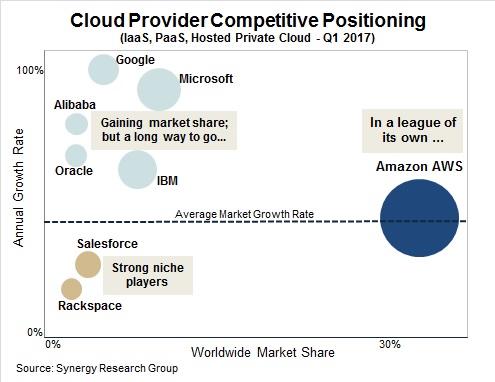The growth of cloud computing drew all the major players towards it. Amazon, Microsoft, IBM, Google and Oracle all have a stake in the game, each spending billions of dollars every year to improve their position in the market. But despite deep-pocketed, established tech majors entering the fray, Amazon has steadfastly held its ground.
Q1 data from Synergy Group shows that Amazon Web Services holds 33% of worldwide market share of IaaS, Paas and Hosted Private Cloud, and continues to grow at the average market growth rate, while smaller players were able to grow at a much faster rate.
Admittedly, Amazon Web Services’ revenue growth rate has been coming down over the past several quarters, but that has got more to do with the fact that Amazon’s revenue keeps getting bigger and bigger with each quarter, and not necessarily because one of their competitors has started to eat them for lunch and dinner.
Microsoft has been chasing Amazon on the IaaS front for many years now, Diane Greene will complete two years as the head of Google’s cloud division this November, Oracle’s Larry Ellison famously said that Amazon’s “lead is over” last year, and IBM spent billions of dollars shopping for cloud companies, but none of them have been able to slow the march of Amazon in the cloud infrastructure segment.
Cloud computing, as an industry, is not a new phenomenon. It has been around for more than a decade, so the argument that Amazon had a head start over other companies and that’s why they are in the lead will no longer wash.
Yes, it did give them the space to work their way up and build their product offerings to an astounding level, and it gave them time to build a strong network of data centers around the world, something that Google and Oracle are doing only now.
And there are several advantages they gained from pushing cloud computing in a big way before anyone else, but are those the only reasons they’re staying put at the top of the cloud infrastructure market?
We don’t think so.
The real reason behind AWS staying at the top is the company’s relentless focus on expanding its products and services, and the fact that their concentration has always been riveted to Infrastructure as a Service.
Amazon says that the company launched 700 new services in 2015, and added another 1000+ services last year.
“If you look at the amount of capability today from where we were when we started 10 years ago, it’s just night and day,” he said, noting that Amazon Web Services will launch close to 1,000 new services and features this year alone, up from 70 in its first year. “And yet, we still feel like we’re at the relative beginning.” – GeekWire, quoting AWS CEO Andy Jassy
The frenzied focus on adding more services puts anyone competing against Amazon Web Services under intense pressure. And, as Amazon keeps rolling out service after service, it keeps improving AWS’ standing in the eyes of the customer as well.
Another important factor to consider is that Amazon can keep cutting the prices of individual services, knowing full well that new services will more than compensate for any revenue lost to discounting. Not really a surprise, then, that Amazon Web Services margins are around a healthy 30% mark despite the company cutting prices at an alarming frequency.
From the customer’s standpoint, this is a huge thing. They know that a price cut is always right around the corner, and they also know that Amazon will keep launching more services that keep making their development teams’ jobs easier.
For small and medium-sized companies, that means they’re not even looking at a contingency where the cost factor will dictate the need to migrate to another provider. Why would they?
As it stands today, competitors have yet to provide a good enough reason for Amazon’s clients to switch over; and unless they do so, removing Amazon from the number one position in the IaaS segment is simply not going to happen.
In fact, it’s Amazon that’s keeping the competition on its toes, not the other way around as should be the case with an industry leader surrounding by deep-pocketed cloud computing competitors.
Thanks for visiting! Would you do us a favor? If you think it’s worth a few seconds, please like our Facebook page and follow us on Twitter. It would mean a lot to us. Thank you.




